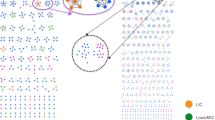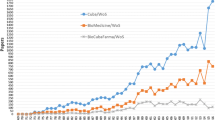Abstract
This paper aims to analyse the collaboration network of the 6th Framework Programme of the EU, specifically the “Life sciences, genomics and biotechnology for health” thematic area. A collaboration network of 2,132 participant organizations was built and several variables were added to improve the visualization such as type of organization and nationality. Several statistical tests and structural indicators were used to uncover the main characteristic of this collaboration network. Results show that the network is constituted by a dense core of government research organizations and universities which act as large hubs that attract new partners to the network, mainly companies and non-profit organizations.

Similar content being viewed by others
References
Barabasi, A. L., & Albert, R. (1999). Emergence of scaling in random networks. Science, 286(5439), 509–512.
Barabasi, A. L., Albert, R., & Jeong, H. (2000). Scale-free characteristics of random networks: The topology of the world-wide web. Physica A, 281(1–4), 69–77.
Barabasi, A., Jeong, H., Neda, Z., Ravasz, E., Schubert, A., & Vicsek, T. (2002). Evolution of the social network of scientific collaborations. Physica A, 311(3–4), 590–614.
Barber, M. J., Krueger, A., Krueger, T., & Roediger-Schulga, T. (2006). The network of European research and development projects. Physical Review E Statistical Nonlinear and Soft Matter Physics, 73(3), 1–13.
Biotechnology Industry Organization. (2008). Technology, talent and capital: State biosciences initiatives 2008. Washington: Battelle. Retrieved October 07, 2009 http://bio.org/local/battelle2008/State_Bioscience_Initiatives_2008.pdf.
Borgatti, S. P., Everett, M. G., & Freeman, L. C. (2002). Ucinet for windows: Software for social network analysis. Harvard, MA: Analytic Technologies.
Breschi, S., & Cusmano, L. (2004). Unveiling the texture of a European research area: Emergence of oligarchic networks under the EU framework programmes. International Journal of Technology Management, 27(8), 747–772.
Cabo, P. G. (1999). Industrial participation and knowledge transfer in joint R&D projects. International Journal of Technology Management, 18(3–4), 188–206.
Dunn, O. J. (1961). Multiple comparisons among means. Journal of the American Statistical Association, 56(1961), 54–64.
European Commission. (2008). FP6 final review: Subscription, implementation, participation. Brussels: Research Directorate General. http://ec.europa.eu/research/reports/2008/pdf/fp6-final-review.pdf.
Freeman, L. C. (1979). Centrality in networks: I. conceptual clarification. Social Networks, 1, 215–239.
Freeman, L. C. (1980). The gatekeeper, pair-dependency, and structural centrality. Quality and Quantity, 14, 585–592.
Fruchtermann, T. M. J., & Reingold, E. M. (1991). Graph drawing by force-directed placement. Software Practice and Experience, 21(11), 1129–1164.
George, G., Zahra, S. A., & Robley Wood, D. (2002). The effects of business-university alliances on innovative output and financial performance: A study of publicly traded biotechnology companies. Journal of Business Venturing, 17(6), 577–609.
Gusmao, R. (2000). Developing and using indicators of multilateral S&T cooperation for policy making: The experience from European research programmes. Scientometrics, 47(3), 493–514.
Kruskal, W. H., & Wallis, W. A. (1952). Use of ranks in one-criterion variance analysis. Journal of the American Statistical Association, 47(260), 583–621.
Leydesdorff, L. (2004). Clusters and maps of science journals based on bi-connected graphs in Journal Citation Reports. Journal of Documentation, 60(4), 371–427.
Mcmillan, G. S., Narin, F., & Deeds, D. L. (2000). An analysis of the critical role of public science in innovation: The case of biotechnology. Research Policy, 29(1), 1–8.
Newmann, M. E. (2001). Scientific collaboration networks. I. Network construction and fundamental results. Physical Review E, 64(1), 016131.
Nooy, W., de Mrvar, A., & Batagelj, V. (2005). Exploratory social network analysis with Pajek. Cambridge, UK: Cambridge University Press.
OECD. (2003). Frascati manual 2002. Paris: OECD Publishing.
Pastor-Satorras, R., & Vespignani, A. (2001). Epidemic spreading in scale-free networks. Physical Review Letters, 86(14), 3200–3203.
Polis, G. A., & Strong, D. R. (1996). Food web complexity and community dynamics. The American Naturalist, 147(5), 813–846.
Price, D. de S. (1976). A general theory of bibliometric and other cumulative advantage processes. Journal of the American Society for Information Science, 27, 292–306.
Roediger-Schulga, T., & Barber, M. J. (2007). R&D collaboration networks in the European framework programmes: Data processing, network construction and selected results (pp. 1–39). Maastricht: United Nation University.
Roediger-Schulga, T., & Dachs, B. (2006). Does technology affect network structure? A quantitative analysis of collaborative research projects in two specific EU programmes (pp. 1–29). Maastricht: United Nation University.
Seidman, S. B. (1983). Network structure and minimum degree. Social Networks, 5, 269–287.
Small, H. (1999). Visualizing science by citation mapping. Journal of the American Society for Information Science, 50(9), 799–813.
Valverde, S., Sole, R. V., Bedau, M. A., & Packard, N. (2007). Topology and evolution of technology innovation networks. Physical Review E, 76(5), 056118.
Wagner, C. S., & Leydesdorff, L. (2005). Network structure, self-organization, and the growth of international collaboration in science. Research Policy, 34(10), 1608–1618.
Watts, D. J., & Strogatz, S. H. (1998). Collective dynamics of ‘small-world’ networks. Nature, 393, 440–442.
Acknowledgments
We wish to thank the R&D Framework Programmes Department of the Centre for the Development of Industrial Technology (CDTI) of Spain for their support and the supply of 6th EU Framework Programme data.
Author information
Authors and Affiliations
Corresponding author
Rights and permissions
About this article
Cite this article
Ortega, J.L., Aguillo, I.F. Shaping the European research collaboration in the 6th Framework Programme health thematic area through network analysis. Scientometrics 85, 377–386 (2010). https://doi.org/10.1007/s11192-010-0218-4
Received:
Published:
Issue Date:
DOI: https://doi.org/10.1007/s11192-010-0218-4




